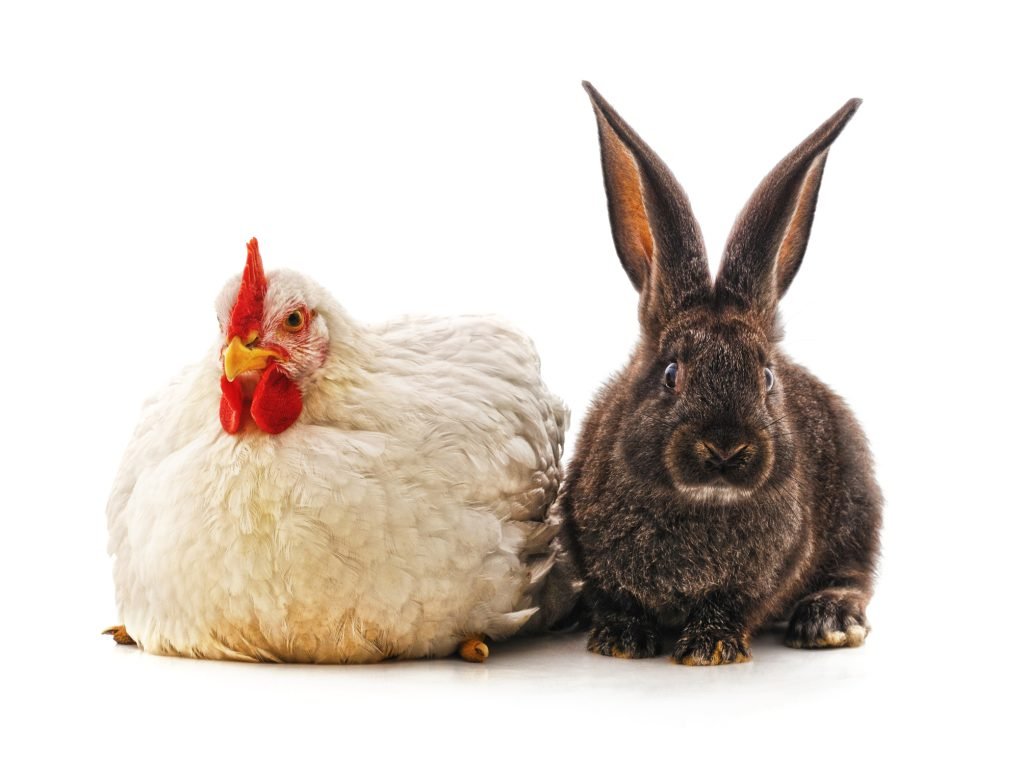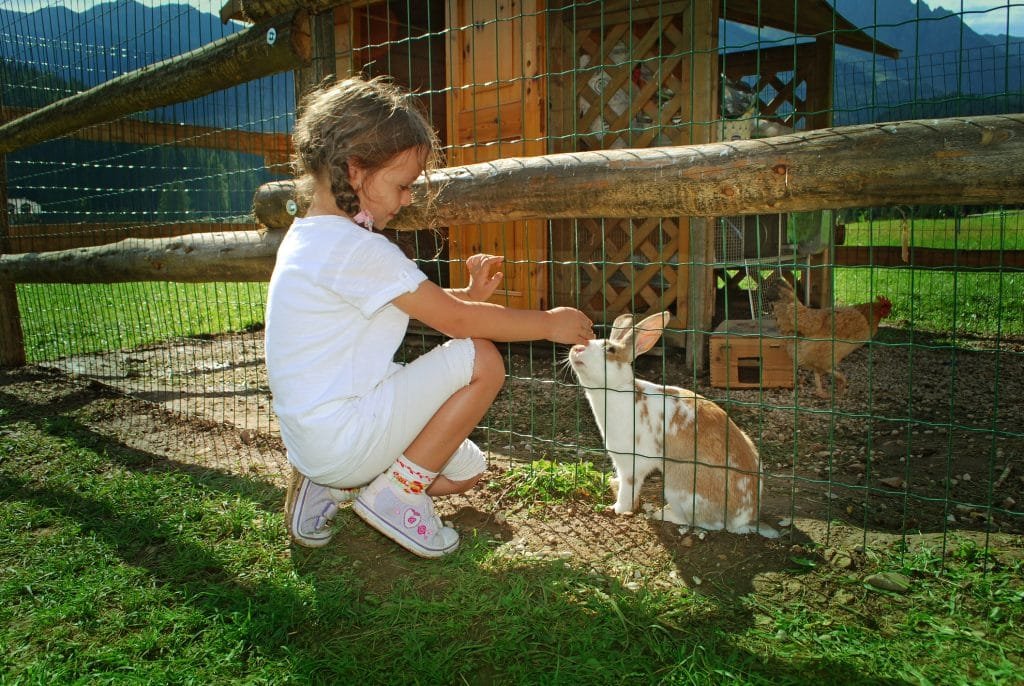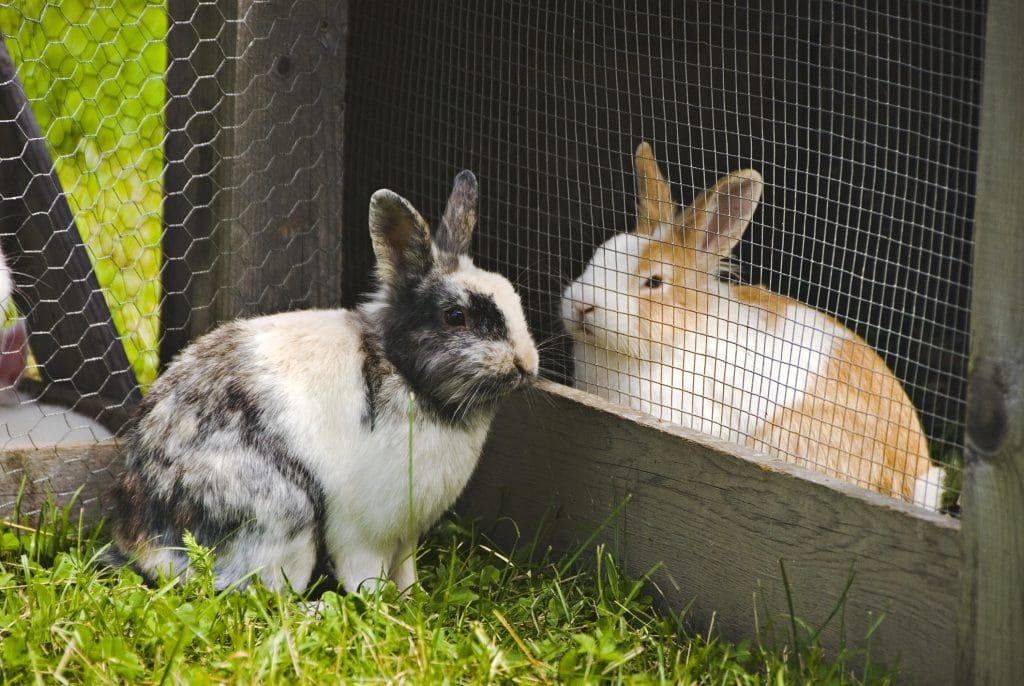This post contains affiliate links.
Rabbits are a common household pet but in many places, rabbits are also considered a great source of meat. With many people looking for a lean, healthy source of protein the question arises, is rabbit meat healthier than chicken meat?
Although rabbit and chicken meat are considered healthier than red meat, rabbit meat is more nutritious than chicken due to its higher protein, phosphorus, and calcium content. Rabbit, furthermore, has lower fat, sodium, and calorie composition than chicken.
Rabbit is healthier than chicken due to its composition, but are there other factors that influence meat’s “health” qualities? What is healthy, and what is unhealthy meat? Do the farming practices of rabbits and chickens affect their nutrition/health value? And why exactly is rabbit healthier than chicken?

Why Is Rabbit Meat Healthier Than Chicken?
Basically, rabbit meat is healthier than chicken, because it has more of the good things our bodies require, while simultaneously, containing less of the bad things, which often lead to diseases, unhealthy living/lifestyles, and premature death.
The question, “Why does rabbit contain more of the good and less of the bad?” is a bit more of a complicated answer. Rabbit meat is healthier than chicken primarily because:
- The way in which rabbits assimilate the food they eat into their bodies.
- The type of food rabbits eat.
- The way that rabbits are farmed and their lifestyle.
These factors are linked to one another and create the situation for healthy meat. What a rabbit eats and how much it is allowed to move are very important as this promotes muscle development.
Rabbit Physiology, Digestion, And Lifestyle Creates Healthier Meat
Rabbits are hind-gut fermenters; which means food passes “quickly” through a rabbit’s stomach and small intestines with little nutrient uptake. Between the small and large intestine are two bacteria filled pockets (caecum). The bacteria in these caeca break down cellulose within plant cells, allowing the rabbit’s body to take up the last bit of nutrients in the large intestine.
This digestive method is wasteful as the rabbit passes most of these nutrients through their system and excrete it in their feces. A rabbit’s body, therefore, needs to draw out the most amount of nutrients possible, prioritizing the most important nutrients for muscle growth and body functioning.
Rabbits’ muscles are well designed for running away from predators (even when domesticated, they still possess these traits). Therefore, energy, oxygen, and other nutrients are stored in these muscles for quick use. These important nutrients take the place of fats and other unwanted compounds, creating healthier meat.
It is important to note, that if a rabbit is restricted in movement, these muscles are used less and are therefore potentially under-developed. Free range rabbits, who are allowed to forage semi-naturally, with some added supplements, produce better quality meat with less fat.
Rabbits require roughage, fibrous indigestible material, as the bulk of their diets, as it takes longer to pass through their system. Rabbit’s bodies are able to assimilate this roughage far more efficiently than chickens can. While farmers grow rabbits on roughage (with added concentrate), chickens need concentrates as a staple. Concentrates are high in carbohydrates which, in excess, create fat. Additionally, salts and antibiotics are added to concentrates.
These factors result in chickens often eating unhealthy foods, which they assimilate into their bodies, and which we, the consumers, take into our own bodies.
Although concentrated (pelleted) food enhances growth, due to the excess protein available, overall, it is healthier to have a higher roughage diet, for the rabbit (any farmed animal) and the consumer.
Nutritional Benefits Of Rabbit Vs. Chicken Meat
When quantifying the nutritional value of meat, particular elements are observed. The table below compares rabbit meat to chicken regarding the amount and type of nutrients found per serving. The serving size is based on 3.5 ounces (100g).
| Nutritional Content per serving (3.5 ounce/100 g) | Rabbit (3.5 ounce/100 g serving) | Chicken |
|---|---|---|
| Protein Content | 33 g | 27 g |
| Calcium Content | 21.4 mg | 12.1 mg |
| Phosphorus Content | 347 mg | 252 mg |
| Iron Content | 4.9 mg | 1.3 mg |
| Zinc Content | 0.95 mg | 1 mg |
| Iodine Content | 7.8 μg | 2.4 μg |
| Vitamin Content | ||
| thiamine | 0.05 mg | 0.043 mg |
| riboflavin | 0.11 mg | 0.119 mg |
| niacin | 5.3 mg | 6.536 mg |
| vitamin B6 | 0.6 mg | 0.4 mg |
| vitamin B12 | 6,5 µg | 0,3 µg |
| Fat Content | 3.5 g | 14 g |
| Saturated Fat | 1.1 g | 3.8 g |
| Cholesterol Content | 56.4 mg | 68.3 mg |
| Sodium Content | 40.5 mg | 71.4 mg |
| Calories | 147 | 239 |
| Omega 3 fatty acid | 320 mg | 40 mg |
When comparing these two sources of animal proteins, we see that in a few ways, they are similar. However, there are several points where a rabbit is the healthier, more nutritious option, particularly in the amount of iron, vitamin B12, protein, calcium, and phosphorus.
Rabbit has less sodium, fat, and cholesterol content than chicken.
The linoleic acid in rabbit meat is also believed to reduce the likelihood of developing cancer. Rabbit meat also contains higher amounts of omega 3 fatty acids than chicken.
Rabbit Vs. Chicken Further Investigated In Terms Of Health
Although both rabbit and chicken meat are much healthier options (farming practices aside) than traditional red meats, when comparing the two types of meat, rabbit meat is the more nutritious of the two overall.
In a study conducted in 2013, researchers compared the nutritional composition of rabbits to pork, chicken, and beef.
The results and conclusion they drew were that rabbit meat was the richest in calcium (21.4 mg/100 g) and phosphorus (347 mg/100 g). They discovered that rabbit meat has the least cholesterol (56.4 mg/100 g), around half the amount found in beef, and fat (9.2 g/100 g).
Their study concluded that rabbit is the healthiest of the meats compared. This health benefit was due to its high protein and low-fat ratios/composition.
Rabbits’ eating and food processing methods also contribute to their healthy meat status. Rabbits are roughage feeders (hindgut fermenters) that forage for food. They, therefore, don’t need to eat concentrated foods (corn and soya-rich foods) to grow effectively. This lack of concentrate improves the quality of the meat as well.
Although slightly more expensive than chicken, rabbits are superior to consume. However, even with all of these benefits, rabbit meat is far behind the other types of meats in popularity.
The most prominent reason for this is the psychological factor.
Many people view rabbits as pets, not food, and this mental block prevents them from reaping the rewards of eating rabbit meat.
When presented with the option to eat rabbit, many people (Europeans aside) cannot detach themselves from the thought of eating a cuddly, cute bunny.

Other Factors Contributing To Which Meat Is Healthier
Rabbit and chicken meat, by their virtues, are healthier than beef, pork, and lamb. But, nutrient composition alone is not the only determining criteria. Other factors influence the health value of the meat eaten by the consumer.
Store-Bought Vs. Home Grown
The benefit of rabbit and chicken is that you can farm them on a smallholding with relative ease. With the number of issues, health concerns, and costs involved with food and meat in general, the ability to grow your food is a tremendous benefit.
When producing your animals for meat, you have the benefit of knowing where it comes from, what it’s fed, how it’s slaughtered and processed, the “cold chain,” what antibiotics, hormones, and other medicines are, or aren’t added, as well as the living conditions.
These benefits are not always reciprocated through store-bought meat. Most shops try to source locally from reputable farmers, but the reality is that you don’t know what went into the product.
Anything that can be bought directly from the farmer (especially one you know and trust) or can grow yourself should be the healthier option compared to store-bought products.
Farming Practices Of Rabbit And Chickens
Whether your meat is store-bought, from the farm, or your efforts, the farming method used to raise, slaughter, and process the livestock is paramount.
Rabbits and chickens require far less space than cattle, pigs, goats, or sheep.
Rabbits, in particular, reproduce and reach slaughter weight swiftly. They have a gestation of 30 days, followed by 30 days of lactation.
Once weaned, the weanlings (fryers) reach slaughter weight at around three months old, depending on the diet. This weight is between 1.5 and 3.5 pounds.
Rabbit farms also tend to have less impact on increasing the speed of climate change and other environmental pressures.
The most crucial point around farming with rabbits and chickens is the conditions they are kept in and their medications. Free-range animals have space to move and develop stronger muscles in doing so.
What you feed rabbits and chickens also is essential. Both could be kept on a concentrate; however, supplementing their diets with fresh fruit and vegetables or even cutting out the concentrate completely for a natural-based diet will improve the livestock’s health and, by extension, the quality of the meat produced.
Both rabbits and chickens have value-added benefits. Chickens produce eggs, while rabbit skins (hides) make fantastic leather and other items.
Both rabbits and chickens produce quality compost from their manure which could be sold or used to help grow food in a veggie garden.
Farmed Rabbit Vs. Hunted Rabbit
The source and age of the rabbit consumed also dictates the nutritional qualities of said rabbit.
Wild rabbits, for example, have close to double the amount of iron that rabbits that are farmed have. However, farmed rabbits have double the selenium that wild rabbits possess.
Due to their feeding and breeding, domesticated rabbits have higher concentrations of vitamins and minerals when compared to wild rabbits. Find out if you have enough space to start raising your own rabbits in my article, How Much Land Do You Need To Raise Rabbits?
Farmed rabbits are often exposed to feeding interventions. They are less exposed to the stresses that wild rabbits are, and they are monitored to ensure good health; because of these factors and selective breeding over many generations, farmed (domesticated) rabbits are generally more nutritious than wild rabbits.
However, there are many similarities in which nutrients occur in both. Generally, the concentrations, the taste, and the capturing method differ.

Why Rabbit Is Considered A “Healthy” Meat
Rabbits are a white meat, and are considered healthier than red meat. Healthy meats have reduced amounts of saturated (and trans) fats, LDL cholesterol, antibiotics, and growth hormones.
Rabbit, and other healthy meats, are also chock full of vitamins (B12 and B6 in particular), nutrients/minerals (including zinc, iodine, and iron), amino acids, and others (like omega acids).
More experts encourage migration from red meats (beef, pork, lamb, etc.) to white meats (fish, chicken, and rabbit) as nutrition research continues.
These white meats have all the “good things” found in red meat, with minimal saturated fats, cholesterol (undesirable), and added antibiotics and hormones depending on the farming techniques.
Rabbit, although not as healthy as fish in terms of iron, protein, and omega acids, is healthier than chicken, and should therefore be prioritized in terms of consumption.
What Causes Meat To Be Considered As Unhealthy?
The factors which cause meat to be “unhealthy” are a bit of a controversial point. Some researchers agree that some of these elements are bad, while others suggest that they are not.
For the most part, our bodies need proteins, minerals and nutrients found in meat; there are other undesirable elements too. These include:
● Saturated fats. These supposed unhealthy fats are linked to increased cholesterol build-up in the body, risk of heart disease, cancer, other diseases, and overarching health problems.
● Trans fats are other potentially harmful types of fats. These are generally found in lower concentrations in meat, and research is needed before a decisive decision can be reached regarding the risks naturally occurring trans fats pose.
● LDL Cholesterol. Due to the LDL particles moving cholesterol into your arteries, it is considered the “bad” type of cholesterol (as opposed to HDL, which removes cholesterol from your body by transporting it to your liver to be broken down).
Increases in cholesterol in your arteries increase your risk of heart disease, stroke, cancer, and other health complications.
● Antibiotics and hormones. Many commercial farmers add antibiotics and growth hormones to their animals to fight disease (brought about through high stocking densities) and increase growth and meat production.
These added elements can carry through into the meat, and the consumer stands a chance of absoring these elements into their bodies.
Although there is still a lot of speculation, it is generally accepted that higher consumption of red meat and dairy increases these undesirable elements in our bodies.
Final Thoughts
Rabbit meat is superior to chicken due to its higher concentration of proteins, phosphorus, calcium, and reduced amounts of fat. Both animals are popular amongst homesteaders and small-scale farmers due to their low farming requirements, in particular space. The consumption of rabbit meat has many benefits, but until people can get past the mental block of eating a cute “bunny,” it will not be as popular as chicken and other meats.
